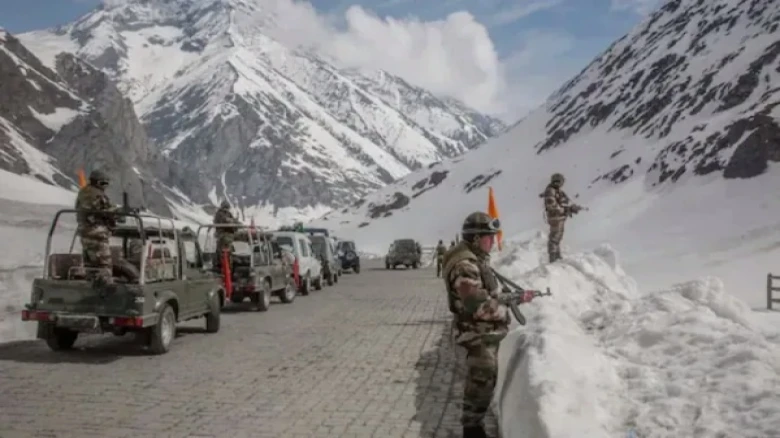The incident occurred just days after China objected to Operation Yudhabhyas, an India-US joint military exercise in Auli in the Uttarakhand hills...
Digital Desk: In the early hours of December 9, Indian and Chinese forces squabbled in Arunachal Pradesh's Tawang sector, beating each other up with clubs and canes in their closest confrontation since the tragic Galwan incident in eastern Ladakh in June 2020.
According to sources, the Indian soldiers who were hurt in the clash are being treated in a hospital in Guwahati.
According to an Army commander, the "fighting resulted in minor casualties to a few people from both sides." "Immediately, both sides disengaged from the region. As a result of the event, the officer's own (Indian) commander in the region convened a flag meeting with his counterpart to examine the issue in accordance with defined protocols to restore peace and tranquillity."
The incident occurred just days after China objected to Operation Yudhabhyas, an India-US joint military exercise in Auli in the Uttarakhand hills, claiming it violated boundary accords signed in 1993 and 1996.
The ongoing military tensions at various sites along the 3,000 km-Line of Actual Control come as New Delhi begins its presidency of the G-20, a collection of the world's major nations that includes China.
In addition, Prime Minister Narendra Modi and President Xi Jinping met in November at the G-20 conference in Bali and exchanged formalities but did not hold any substantial talks or discussions.
The clash in Arunachal Pradesh occurred last Friday around 3 a.m. at a nullah along the LAC in the Tawang heights near Yangtse in Eastern Tawang. According to military sources, this section of the LAC is one of the "accepted contested zones" between the two sides.
Indian and Chinese forces are stationed on either side of the nullah, but on this night, 300 Chinese troops crossed into Indian territory.
There were no warning signals of the violation, and upon hearing the assault on the sentries, some 70 to 80 Indian forces mobilised rapidly in the middle of night to push back the intruders. According to accounts, there was fierce hand-to-hand combat with sticks and canes for a few hours.
The fight was "more than pushing and shoving," according to the sources, however it was unclear whether either side suffered major injuries.
"PLA troops made touch with the LAC in Tawang Sector, which was vigorously defended by our troops." "This clash resulted in minor injuries to a few people from both sides," said a military source.
According to the source, both parties "immediately" retreated from the region, and "our Commander in the area had a Flag Meeting with his counterpart to discuss the situation in accordance with structured protocols to restore peace and serenity."
"There are places of divergent perception along the LAC in the Tawang Sector of Arunachal Pradesh, where both sides monitor the area up to respective claim lines." This has been the case since 2006, as stated by the military source.
A similar breach occurred in June 2016, when approximately 250 PLA soldiers entered the region, although no conflicts were recorded. According to a military official who has served in the area, it is impossible to forecast when the PLA will conduct such operations because "the Chinese continuously control the escalatory ladder in that area" and do so "at their discretion."
Based on a high government source, the PLA "pre-planned" the infraction for a "opportune" period this time. The fight takes place in thickly forested terrain, with Chinese troops establishing "top of the wall" positions with extensive supply lines and infrastructure.
As per the source, this was also the moment for some Indian troops to retreat from their posts due to snowfall in the area, providing the Chinese side a tactical advantage. A dense cloud cover also made it difficult for Indian satellites to detect any troop buildup.
The Indian side is believed to have employed Radio Frequency (RF) signal localization technology after the fight to recreate satellite photos. The Indian military and security apparatus is currently analysing the high-resolution satellite imagery.
The incident has raised the level of alertness among troops in the area. Just three months ago, in September, Indian and Chinese soldiers disengaged in the Gogra Hotspring area of Eastern Ladakh, the final of 16 rounds of military commander level negotiations that began in May 2020, following Chinese incursions at multiple places in the area.
The Galwan incident, which killed 20 Indian soldiers, occurred after the two sides discussed disengagement in the area.
Tensions in Ladakh remain high due to the presence of Chinese troops in Depsang, invasions in Demchok, and the Chinese's quick infrastructure construction, including two bridges over Pangong Lake that will shorten Chinese mobilisation time on the southern bank.
External Affairs Minister S Jaishankar recently stated that "until there is peace and serenity in the border areas... unless there is observance of agreements and no unilateral attempt to change the status quo... the situation cannot be, and is not, normal."

Leave A Comment